|
This species has been introduced into California. It is not a native species.
|
It is unlawful to import, transport, or possess this species in California
except under permit issued by the California Department of Fish and Wildlife.
(California Code of Regulations, Title 14, Excerpts, Section 671)
|
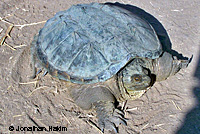 |
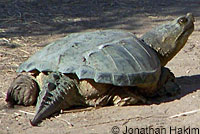 |
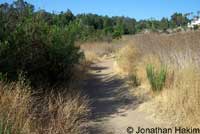 |
| Adult, found crossing a trail near a small lake in Orange County. © Jonathan Hakim |
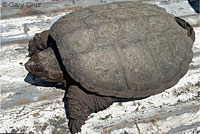 |
 |
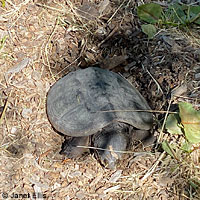 |
Adult, found on an urban watershed trail in mid May in Alameda County
© Gary Cruz |
This adult female was photographed in early June laying eggs in a nest she dug near the same Alameda County lake where the snapping turtle shown to the left was found. © Janet Ellis |
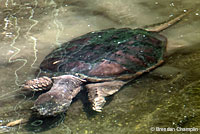 |
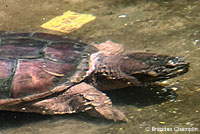 |
|
| Adult in a creek in Concord, Contra Costa County © Brendan Champlin |
|
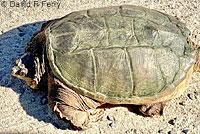 |
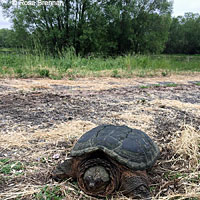 |
|
This approximately 20-inch-long adult was photographed on the road of a wildlife refuge in Riverside County.
© David R Ferry. |
Adult, observed next to a body of water in Sonoma County. © Rose Brennan |
|
| |
|
|
| Snapping Turtles From Outside California |
 |
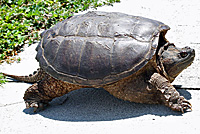 |
 |
 |
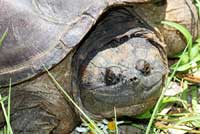 |
|
| Adult found about to cross a busy road on a hot April afternoon in Brevard County, Florida |
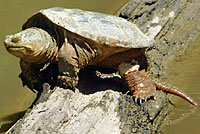 |
 |
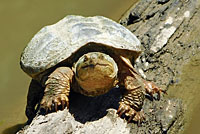 |
| Basking adult, Fairfax County, Virginia |
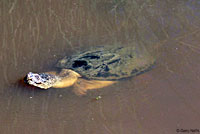 |
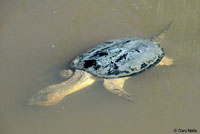 |
 |
| |
Adult, Fairfax County, Virginia |
|
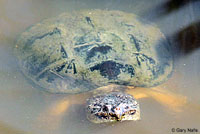 |
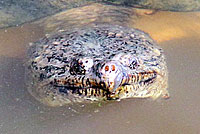 |
 |
| |
Adult, Fairfax County, Virginia |
|
 |
 |
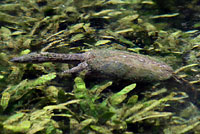 |
| Adult, Tompkins Co., NY © Joyce Gross |
Large old adult swimming on top of aquatic vegetation,
showing the very long neck of this species, Hays County, Texas |
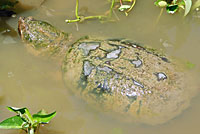 |
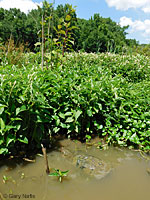 |
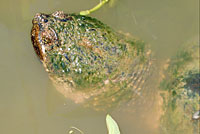 |
| Adult eating aquatic vegetation, Fairfax County, Virginia |
 |
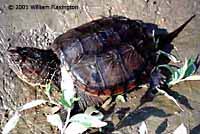 |
 |
| Juvenile, Cumberland County, Pennsylvania © William Flaxington |
Adult, Williamson, TE © Lisa Powers |
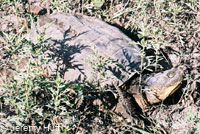 |
 |
|
| Adult, Kansas © Jeremy Huff |
|
| |
|
| California Habitat |
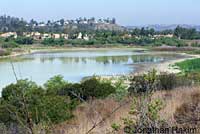 |
 |
 |
| Habitat, Orange County. © Jonathan Hakim |
©1998 Allen McConnell
According to news reports, the resident snapping turtles in this pond in San Francisco occasionally bite off the legs of birds floating on the water. |
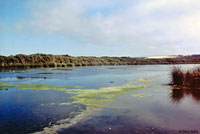 |
 |
 |
| Snapping turtles have shown up in various locations in California, including the lake in San Luis Obispo County shown on the left, and the lake in Santa Barbara County shown on the right. It is not known if all of these populations are established and breeding. |
Urban park lake habitat,
Alameda County
© King of Hearts, CC BY-SA 3.0, via Wikimedia Commons |
| |
|
| Short Video |
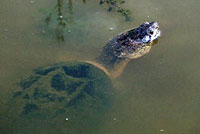 |
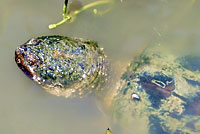 |
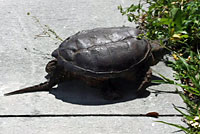 |
Snapping turtles swimming
in a Virginia wetlands |
Snapping turtles have a reputation for being dangerous meat-hungry beasts that bite off the legs of ducks, but here we see one on a hot summer day in a wetlands in Virginia slowly trying to eat small leaves. |
As I was driving on a busy highway in Brevard County, Florida, I saw a snapping turtle trying to cross the highway. I quickly stopped and ran toward it, which caused it to turn around, sparing its life, no doubt. After taking some still shots, I only got a few seconds of video before it sat still. I tried to move it so it would walk again, but decided to give up after it snapped at my fingers a couple of times. Maybe I'll do better next time.... |
|
|
|
| Description |
| |
| Size |
8 to 18.5 inches in shell length (20.3 - 47 cm). (Stebbins 2003)
|
| Appearance |
A large freshwater turtle with a massive head with huge hooked jaws, a long tail, a saw-toothed crest, and a shell that looks like it is too small to fit the body.
The legs are large with webbed toes and heavy claws.
The tail is longer than half the length of the carapace.
Average weight is around 45 lbs, but some captives have weighed in at over 75 lbs. |
| Color and Pattern |
The skin is gray, black, yellow, or tan, with tubercles on the neck.
White flecks occur on some individuals.
The color of the carapace ranges from black, brown, or olive to tan.
Often it is covered with mud or algae, which helps camouflage the turtle.
It is heavily serrated on the rear, and scutes may have a pattern of radiating lines.
The plastron is tan or yellow. |
| Male / Female Differences |
| Males typically grow larger than females. |
| Young |
Young have 3 prominent serrated ridges on the carapace. These ridges become less conspicuous as the turtle ages. The tail of a juvenile is longer than the length of the shell.
|
| Life History and Behavior |
Activity |
Aquatic, found in or near water.
An excellent swimmer.
Considered most active at night in the southern part of its range, it is apparently more active during the day in the northern part of its range, which probably includes the Southern California locations, also.
Sometimes seen basking on or under the surface in shallow water.
Often rests buried in the mud with its eyes and nostrils exposed in water shallow enough that it can raise its long neck up to allow the nostrils to break the surface and breathe without moving out of the mud.
Active most of the year, becoming dormant in areas with cold winters, generally in late October.
Remains dormant either burrowed into the mud bottom, or under overhanging banks, root snags, stumps, brush, logs, or other debris.
Large groups have been found hibernating together, sometimes with other turtle species.
Emerges some time between March to May, depending on the climate. |
| Turtles Walking on Land Do Not Always Need to be Picked Up and Rescued |
| Turtles sometimes leave the water to search for food, a better place to live, a mate, or to lay their eggs in the spring - typically from March to June. If you see a turtle walking on the land, it is probably not sick or lost, so the best thing you can do for the turtle is to leave it alone. Some people want to help a turtle they think is in danger by picking it up and bringing it home or to a wildlife rehabilitation center, but most of the time this harms the turtle by removing it from the wild without reason. Sometimes turtles do get lost or stranded in yards or on busy roads or somewhere where they may be in danger. If you find one in such a situation, it's ok to move it out of danger, but it's best to leave it in a safe place as close to where you found it as possible. |
| Longevity |
| Longevity has been estimated at up to 40 years. |
| Defense |
| Snapping turtles are
ill-tempered and capable of producing a very serious bite. |
| Diet and Feeding |
Omnivorous, eating anything that fits into its jaws, including snails, earthworms, shrimp, crayfish, insects, fish, frogs, salamanders, reptiles, small turtles, snakes, birds, mammals, plants, and carrion.
They can prey on adult waterfowl by grabbing a foot, then grabbing the bird's neck, or pulling it underwater to drown it. (Herpetological Review 48(1), 2017)
Young turtles tend to forage actively, while adults tend to lie in ambush. |
| Reproduction |
Adults become sexually mature in four to five years.
Females crawl onto land, sometimes traveling over great distances, to dig a nest where they lay a clutch of eggs, generally from 20 - 40, (ranging from 6 - 104).
Egg laying takes place mostly in June and July (but can occur any time between May and October).
The eggs hatch in 9 - 18 weeks.
During cold winters, hatchlings will overwinter in the nest.
Females may retain viable sperm for several years, so they do not necessarily need to breed with a male each year to produce viable eggs.
|
| Habitat |
Found in just about every type of freshwater habitat in its natural range, including marshes, ponds, lakes, rivers, and slow streams. Prefers slow-moving shallow waters with a muddy or sandy bottom and abundant aquatic vegetation or submerged roots and trees. Also occurs at the edges of deep lakes and rivers and in brackish coastal waters.
|
| Geographical Range |
Native and Introduced Range
The native range of the species Chelydra serpentina - Common Snapping Turtle is roughly from the east coast of North America to the Rocky Mountains and from southern Canada to the Gulf Coast, and along the east coast of Mexico from Veracruz through Central America to Ecuador. The species has been introduced into a few areas west of the Rockies where it may or may not be established, including Oregon, Washington, Utah, Nevada, Arizona, and California.
Sightings In California
Below are some locations where common snapping turtles have been seen that I have found in books, museum records, iNaturalist, and in emails sent to this web site. Since many snapping turtles seen in California are probably abandoned or escaped pets, it is not possible to know if these turtles represent an established population or just a single individual. A lot of of the turtles reported were captured, which means are no longer found at the location.
There are not many observations of breeding that I'm aware of: a snapping turtle was seen laying eggs at a lake in Fremont, and there are reports of a breeding population in the San Diego River in Mission Valley.
They could be in any body of fresh water in the state. There are probably many more locations I'm not aware of where this turtle has been seen in the state than are listed below or shown on my range map. I will add more locations as I learn of them. You can also, search iNaturalist for common snapping turtles and look at the map to see some of the general areas where they have been found in the state. (iNaturalist's map is intentionally inaccurate, but it gives a good general idea of where they have been reported to that particular website.)
Alameda County
- Lake Elizabeth, Fremont
Butte County
- Bangor Ditch
Contra Costa County
- in a culvert below a roadway in Vine Hill
- a freshwater channel in wetlands adjacent to the San Joaquin River near Oakley. (Found injured in dredging debris.)
- in a canal in Concord
- in Walnut Creek in Concord
- Martinez
Fresno County
- Reported as "...established in vicinity of Fresno...." in Robert Stebbins' 1972 field guides and in "...aquatic habitats in the Fresno area..." in Stebbins & McGinnis, 2012.
Imperial County
- along the Lower Colorado River, Imperial County (Stebbins, 2003)
Los Angeles County
- L. A. County Arboretum, Arcadia
- El Dorado East Regional Park, Long Beach
- Cabrillo Beach, San Pedro (hatchling)
- Piute Ponds at Edwards Air Force Base
- Haines Creek ponds
- Chatsworth Nature Preserve and Pond
Napa County
- the Napa river
Orange County
- the marsh near the UC Irvine campus
- Mile Square Regional Park, Fountain Valley
- Peters Canyon Reservoir
- Huntington Central Park, Huntington Beach (Adult female laying eggs)
Riverside County
- San Jacinto Wildlife Area
Sacramento County
- Gibson Ranch County Park, Elverta
San Bernardino County
- Big Bear Lake
- Lost Lake in the Cajon Pass area
San Diego County
- A nest was seen along the San Diego River in Mission Valley. (Jeffrey M. Lemm (2006).
Other reports confirm that there is a breeding population of snapping turtles in the San Diego river.
- Carlsbad - Buena Vista Creek
- Tecolote Canyon
- Otay Lakes
- Otay River - Otay Valley Regional Park
- in an aqueduct in Oceanside
- Mission Trails Regional Park
- in canals draining into the San Diego River, San Diego
- Otay Valley Regional Park, San Diego
- Brengle Terrace Park in Vista
San Francisco County
- in the pond at the Palace of Fine Arts in San Francisco
- Golden Gate Park, San Francisco
- Lake Merced Park, San Francisco
San Jose County
- Almaden Reservoir, San Jose County
San Luis Obispo County
- Oso Flaco Lake
Santa Barbara County
- Andree Clark Bird Refuge in Santa Barbara (Stebbins, 2003)
- UCSB lagoon
- Childs Estate Zoo
- Alice Keck Memorial Park
Yolo County
- U.C. Davis
|
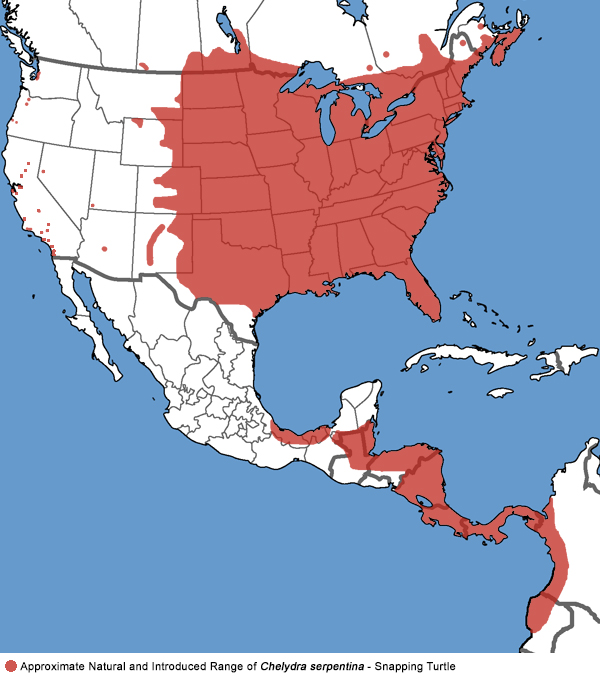 |
| Notes on Taxonomy |
Formerly two subspecies were recognize in the USA:
C. s. serpentina - Common Snapping Turtle, and
C. s. osceola - Florida Snapping Turtle.
Notes from the SSAR
Scientific and Standard English Names List - Herpetological Circular No. 29, 2012:
"Shaffer et al. (2008; Biology of the Snapping Turtle, John Hopkins Univ. Press.) provided convincing genetic evidence that C. serpentina is a "single, virtually invariant lineage" and hence abandoned the recognition of the subspecies C. s. osceola Stejneger, 1918."
---------------------------------------------------------------------------------------------------------------------------------------------------------------------
Notes from the SSAR Herpetological Circular No. 43, published September 2017:
"This species has often been called the Common Snapping Turtle (e.g., Collins, 1997, SSAR Herpetol. Circ. 25). We have dropped the adjective because it might be misinterpreted as referring to the abundance of the species rather than to its being the typical, most widespread species of its family."
Committee On Standard English And Scientific Names, Brian I. Crother (Committee Chair).
Society for the Study of Amphibians and Reptiles. Scientific And Standard English Names Of Amphibians And Reptiles Of North America North Of Mexico, With Comments Regarding Confidence In Our Understanding. Eighth Edition. Herpetological Circular No. 43, published September 2017.
---------------------------------------------------------------------------------------------------------------------------------------------------------------------
Chelydra Schweigger, 1812—American Snapping Turtles
"The standard English name changed from Snapping Turtles to American Snapping Turtles to negate confusion with Macrochelys, the Alligator Snapping Turtles."
(Nicholson, K. E. (ed.). 2025 SSAR Scientific and Standard English Names List)
---------------------------------------------------------------------------------------------------------------------------------------------------------------------
C. serpentina (Linnaeus, 1758)—North American Snapping Turtle
"The standardized English name changed from Snapping Turtle to North American Snapping Turtle to better differentiate it from the Alligator Snapping Turtles (Macrochelys spp.) and align with the usage of the Turtle Taxonomy Working Group (2021, Chelonian Research Monographs (8): 1–472)."
(Nicholson, K. E. (ed.). 2025 SSAR Scientific and Standard English Names List)
---------------------------------------------------------------------------------------------------------------------------------------------------------------------
Alternate and Previous Names (Synonyms)
Chelydra serpentina - North American Snapping Turtle (Hansen and Shedd, 2025)
Chelydra serpentina - Common Snapping Turtle (Stebbins & McGinnis 2018)
Chelydra serpentina - Snapping Turtle (SSAR Scientific and Standard English Names... List, 2017)
Chelydra serpentina - Eastern Snapping Turtle (Powell, Conant, & Collins 2016)
Chelydra serpentina - Common Snapping Turtle (Stebbins & McGinnis 2012)
Chelydra serpentina serpentina - Common Snapping Turtle (Stebbins 1954, 1966, 1985, 2003)
|
| Conservation Issues (Conservation Status) |
This voracious predator may pose a threat to the survival of native animals. It has been introduced into various locations probably due to negligent pet owners. It is not known if turtles in these locations are reproducing, but some nesting has been observed.
It is against the law to capture, move, possess, collect, or distribute this invasive species.
See: California Department of Fish and Wildlife Restricted Species Regulations.
Snapping turtle meat is considered a delicacy, and is often used in turtle soup. Some populations have been severely decimated from overhunting. |
|
|
Taxonomy |
| Family |
Chelydridae |
Snapping Turtles |
Gray, 1870 |
| Genus |
Chelydra |
American Snapping Turtles |
Schweigger, 1812 |
Species
|
serpentina |
Snapping Turtle |
(Linnaeus, 1758) |
|
Original Description |
Chelydra serpentina - (Linnaeus, 1758) - Syst. Nat., 10th ed., Vol. 1, p. 199
from Original Description Citations for the Reptiles and Amphibians of North America © Ellin Beltz
|
|
Meaning of the Scientific Name |
Chelydra - Greek - chelys = turtle + hydros = water serpent - refers to the aquatic nature of the genus.
serpentina - Latin - serpentina = snake-like - refers to the long snake-like neck.
from Scientific and Common Names of the Reptiles and Amphibians of North America - Explained © Ellin Beltz
|
|
Related or Similar California Turtles |
None
|
|
More Information and References |
California Department of Fish and Wildlife
Hansen, Robert W. and Shedd, Jackson D. California Amphibians and Reptiles. (Princeton Field Guides.) Princeton University Press, 2025.
Stebbins, Robert C., and McGinnis, Samuel M. Field Guide to Amphibians and Reptiles of California: Revised Edition (California Natural History Guides) University of California Press, 2012.
Stebbins, Robert C. California Amphibians and Reptiles. The University of California Press, 1972.
Flaxington, William C. Amphibians and Reptiles of California: Field Observations, Distribution, and Natural History. Fieldnotes Press, Anaheim, California, 2021.
Nicholson, K. E. (ed.). 2025. Scientific and Standard English Names of Amphibians and Reptiles of North America North of Mexico, with Comments Regarding Confidence in Our Understanding. Ninth Edition. Society for the Study of Amphibians and Reptiles. [SSAR] 87pp.
Samuel M. McGinnis and Robert C. Stebbins. Peterson Field Guide to Western Reptiles & Amphibians. 4th Edition. Houghton Mifflin Harcourt Publishing Company, 2018.
Stebbins, Robert C. A Field Guide to Western Reptiles and Amphibians. 3rd Edition. Houghton Mifflin Company, 2003.
Behler, John L., and F. Wayne King. The Audubon Society Field Guide to North American Reptiles and Amphibians. Alfred A. Knopf, 1992.
Robert Powell, Roger Conant, and Joseph T. Collins. Peterson Field Guide to Reptiles and Amphibians of Eastern and Central North America. Fourth Edition. Houghton Mifflin Harcourt, 2016.
Powell, Robert., Joseph T. Collins, and Errol D. Hooper Jr. A Key to Amphibians and Reptiles of the Continental United States and Canada. The University Press of Kansas, 1998.
Robert Powell, Roger Conant, and Joseph T. Collins. Peterson Field Guide to Reptiles and Amphibians of Eastern and Central North America. Fourth Edition. Houghton Mifflin Harcourt, 2016.
Bartlett, R. D. & Patricia P. Bartlett. Guide and Reference to the Turtles and Lizards of Western North America (North of Mexico) and Hawaii. University Press of Florida, 2009.
Carr, Archie. Handbook of Turtles: The Turtles of the United States, Canada, and Baja California. Cornell University Press, 1969.
Ernst, Carl H., Roger W. Barbour, & Jeffrey E. Lovich. Turtles of the United States and Canada. Smithsonian Institution 1994.
(2nd Edition published 2009)
Lemm, Jeffrey. Field Guide to Amphibians and Reptiles of the San Diego Region (California Natural History Guides). University of California Press, 2006.
|
|
|
The following conservation status listings for this animal are taken from the July 2025 State of California Special Animals List and the July 2025 Federally Listed Endangered and Threatened Animals of California list (unless indicated otherwise below.) Both lists are produced by multiple agencies every year, and sometimes more than once per year, so the conservation status listing information found below might not be from the most recent lists, but they don't change a great deal from year to year.. To make sure you are seeing the most recent listings, go to this California Department of Fish and Wildlife web page where you can search for and download both lists:
https://www.wildlife.ca.gov/Data/CNDDB/Plants-and-Animals.
A detailed explanation of the meaning of the status listing symbols can be found at the beginning of the two lists. For quick reference, I have included them on my Special Status Information page.
If no status is listed here, the animal is not included on either list. This most likely indicates that there are no serious conservation concerns for the animal. To find out more about an animal's status you can also go to the NatureServe and IUCN websites to check their rankings.
Check the current California Department of Fish and Wildlife sport fishing regulations to find out if this animal can be legally pursued and handled or collected with possession of a current fishing license. You can also look at the summary of the sport fishing regulations as they apply only to reptiles and amphibians that has been made for this website.
It is against the law to capture, move, possess, collect, or distribute this invasive species.
See: California Department of Fish and Game Restricted Species Regulations
|
| Organization |
Status Listing |
Notes |
| NatureServe Global Ranking |
|
|
| NatureServe State Ranking |
|
|
| U.S. Endangered Species Act (ESA) |
None |
|
| California Endangered Species Act (CESA) |
None |
|
| California Department of Fish and Wildlife |
None |
|
| Bureau of Land Management |
None |
|
| USDA Forest Service |
None |
|
| IUCN |
|
|
|
|















































